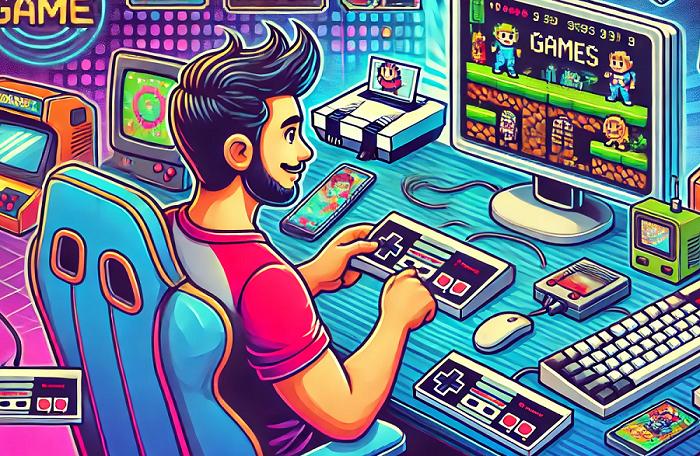How to Play Emulator Games - Complete Guide

Emulator games have become a popular way to relive the nostalgia of classic gaming consoles on modern devices. Whether you want to play classic NES, SNES, PlayStation, or arcade games, emulators allow you to experience these titles on your computer, smartphone, or even smart TV. If you're new to emulation, this guide will walk you through setting up and playing emulator games step by step.
1. What is an Emulator?
An emulator is a software program that replicates the hardware of a gaming console, allowing you to run games designed for that system on another device. Emulators work by mimicking the functionality of consoles, making it possible to play classic games without the original hardware.
Some popular emulators include:
- RetroArch (Multi-system emulator)
- Dolphin (GameCube & Wii emulator)
- PCSX2 (PlayStation 2 emulator)
- PPSSPP (PlayStation Portable emulator)
- MAME (Arcade game emulator)
2. Choosing the Right Emulator
The first step in playing emulator games is selecting the correct emulator for the console you want to emulate. Here’s a quick guide:
|
Console |
Recommended Emulator |
|
NES |
Nestopia, FCEUX |
|
SNES |
SNES9x, ZSNES |
|
Game Boy Advance |
VisualBoyAdvance |
|
PlayStation 1 |
ePSXe, DuckStation |
|
PlayStation 2 |
PCSX2 |
|
GameCube & Wii |
Dolphin |
|
Sega Genesis |
Kega Fusion |
|
N64 |
Project64 |
|
PSP |
PPSSPP |
|
Arcade |
MAME |
Each emulator has its strengths; some provide better performance and compatibility than others.
3. Downloading and Installing an Emulator
Once you've chosen the right emulator, follow these steps to download and install it:
- Go to the official website of the emulator you selected.
- Download the latest stable version for your operating system (Windows, macOS, Linux, Android, etc.).
- Extract or install the emulator on your device.
- Open the emulator and configure the settings as needed.
Some emulators require additional BIOS files to run certain games. Check the emulator’s documentation to see if you need a BIOS file and how to install it.
4. Obtaining Game ROMs and ISOs Legally
A game ROM (Read-Only Memory) or ISO is a digital copy of a game that an emulator uses to run games. Downloading ROMs of games you do not own is illegal in many countries. Here’s how to obtain games legally:
- Dump your own game cartridges or discs using compatible hardware.
- Use legal ROM repositories that provide public domain or open-source games.
- Purchase official digital versions of classic games through platforms like Nintendo Virtual Console, PlayStation Store, or Xbox Game Pass.
5. Loading a Game in an Emulator
Once you have a legally obtained ROM, follow these steps to load it into an emulator:
- Open the emulator you installed.
- Locate the ‘Open ROM’ or ‘Load Game’ option in the emulator’s menu.
- Browse to the folder where your game ROM or ISO is stored.
- Select the game file and click ‘Open’ or ‘Run.’
- Start playing!
Some emulators allow you to configure additional settings, such as graphics enhancements, controller mapping, and save states, to improve your gaming experience.
6. Configuring Controls and Graphics
Many emulators allow you to configure the controls and adjust graphics settings for better performance. Here’s how:
Setting Up Controls:
- Open the emulator's ‘Input’ or ‘Controller Settings’ menu.
- Choose your input method (keyboard, gamepad, or joystick).
- Assign buttons according to your preference.
Adjusting Graphics Settings:
- Set the resolution and aspect ratio for your display.
- Enable frame skipping if the game runs too slow.
- Use shaders and filters for a more authentic look.
- Adjust V-sync and anti-aliasing for smoother graphics.
7. Saving and Loading Game Progress
Emulators offer two primary ways to save your progress:
- Native Save System – Some games allow saving in-game, just like on the original console.
- Save States – Emulators allow you to save the exact state of the game at any moment and reload it instantly.
To use save states:
- Press the designated save key in the emulator (e.g., F5 in many emulators).
- To load a save, press the designated load key (e.g., F8).
- Some emulators support multiple save slots for different points in the game.
8. Enhancing the Gaming Experience
To make your experience even better, you can:
- Use cheat codes via the emulator’s built-in cheat system.
- Enhance graphics using texture packs or HD rendering settings.
- Play multiplayer games using netplay features in certain emulators.
- Use rewinds and fast-forward functions to skip cutscenes or undo mistakes.
9. Playing Emulator Games on Mobile Devices
Many emulators have mobile versions for Android and iOS. To play games on mobile:
- Download an emulator app from the Google Play Store or App Store (if available).
- Transfer legally obtained ROMs to your phone.
- Use touchscreen controls or connect a Bluetooth controller.
Some recommended mobile emulators:
- DraStic (Nintendo DS)
- PPSSPP (PSP)
- RetroArch (Multi-system)
10. Legal and Ethical Considerations
While emulators are legal, downloading copyrighted ROMs is not. Always:
- Play games you legally own.
- Support developers by purchasing classic games when available.
- Respect intellectual property laws in your region.
Playing emulator games is a fantastic way to revisit classic titles and experience retro gaming without needing original hardware. You can enjoy countless hours of gaming by selecting the right emulator, legally obtaining games, and configuring settings for the best experience. Whether on a PC, mobile device, or gaming console, emulation opens a world of possibilities for gamers of all ages.
Now that you understand how to play emulator games, go ahead and set up your emulator to start enjoying your favorite classic games today!
Post Your Ad Here
Comments